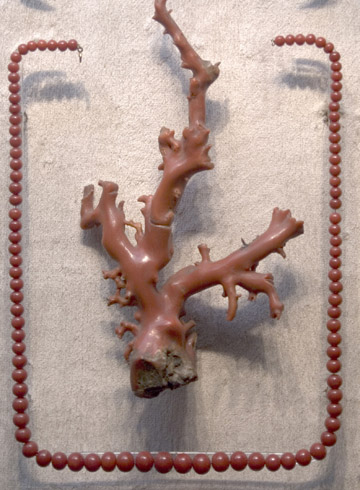
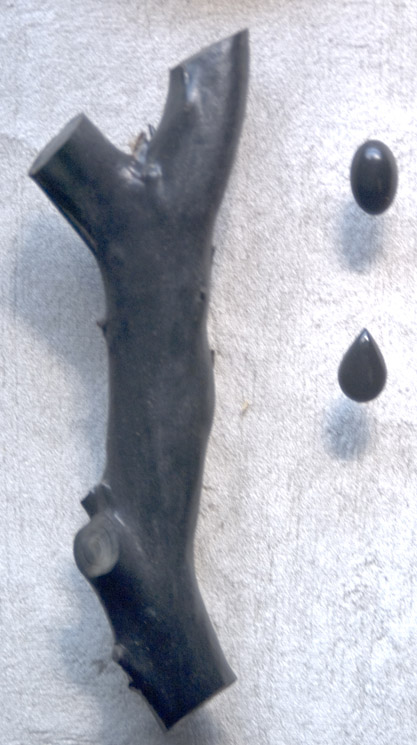
When it comes to living organisms pearls are the most valued product of organic origin and are treated separately. If a living organism is harvested for the purpose of obtaining a product, there is a distinct possibility that the organism or its entire environment may be endangered. Organic gems should therefore be acquired only through legitimate dealers and even then the purchaser should consider the consequences of their actions. Consider that elephant ivory is illegal to import into the United States and that elephants are near to extinction before purchasing such an item. Discussion below will include what information is available about the protection and conservation of organisms that make organic gems.
Ivory
Ivory is harvested tooth material. Elephants, babirusa, wart-hogs, narwhals, hippopotamuses, and perhaps other mammals all produce ivory of one sort or another. Most of these animals are environmentally endangered. Their tooth material is used to make piano keys, carved into many utilitarian and ornamental objects and is popular all over the world.
Ivory typically is a cream to off-white color. It is durable, but yellows and may crack with age. However, even ancient ivory, at least 10,000 years old, from extinct mammoths and mastodons is still used for modern carvings. This ancient ivory is refered to as fossil ivory.
As with bone, tooth material contains calcium along with phosphorus. Ivory is durable, somewhat flexible, and carves well.
Ivory is simulated using dyed bone and plastics. Plastics work fine as a replacement for almost all utilitarian objects. Since elephants and other sources of ivory are endangered by humankind's encroachment on their habitats and by excessive hunting, ivory should become a material only sold in true antiques.
Coral
Again, the news is not good. Coral is threatened by man's activity and by changing environmental conditions due to global warming. The use of coral in jewelry should be discouraged. The harvesting of the coral is not the only danger to the organism's future. Fishing using drag nets and other apparatus is devastating sea bottom environments all over the world.
Coral used in jewelry is the excreted skeleton of the coral animal (phylum Cnidaria, class Anthozoa). The skeleton is composed of calcium carbonate (aragonite) and organic material. Only red to pink (Corallium nobile or Corallium rubrus) and black corals are harvested for the purpose of jewelry. The organic material is less prevalent in red coral and it is more brittle than black coral that is made mainly of a horn-like material. Both types of coral are carved, cabochoned, and used in beads. Colorful corals are also used decoratively.


Until relatively recently, the severity of the danger to corals and the coral reefs was not appreciated. Today both scientists and governments are acting to help prevent global destruction of this important ecological environment that is the home to so many fish and other types of marine life that grow in the shelter of the corals.
Coral can be easily replaced by plastic and perhaps stones that are dyed an appropriate color.
Jet and Anthracite Coal
The news here is good. Jet and coal are fossilized carbon (mainly plant material). There are ample supplies of both these substances and the ecological impact of obtaining them for jewelry is minimal.
Both jet and coal are fossilized deposits of plant material that when buried and compacted form a dark colored, mainly black dense type of hydrocarbon. Though most people think of coal as a hard substance, it is really moderately soft and easily carved and shaped. Coal and jet are usually fashioned into cabochons and are worn in necklaces, brooches, etc. Mostly these dark semiprecious stones were traditionally worn in mourning/funeral jewelry. Their popularity has waned and today they are little used.
Amber
Amber is fossilized tree sap. As such, it is ecologically not a problem to harvest. Much amber comes from the Baltic region, with the world's largest deposits, parts of Russia, Costa Rica, and Myanmar. Amber starts as dripping sap from trees, mostly cone-bearing trees (conifers), such as pines. The exact composition of amber is variable, but it is a carbon compound that may contains succinic acid (amber acid). The sticky sap often catches small insects and occasionally larger animals, and these are preserved in the sap. Amber varies from transparent to cloudy and translucent. Clear, lightly colored amber is most desirable. Insects and other included objects can enhance the interest in the substance. As amber becomes darker and if it is much included with bubble, etc., that make it translucent, its value diminishes.
Less valuable amber is transformed into varnish used to coat wood furniture, etc. Small pieces of good quality amber can be heated and pressed together to create pressed amber. As well, some lower quality amber is treated by heating in oil. This makes it more transparent, but usually caused small circular cracks to form, called spangles (sometimes called sun spangles).
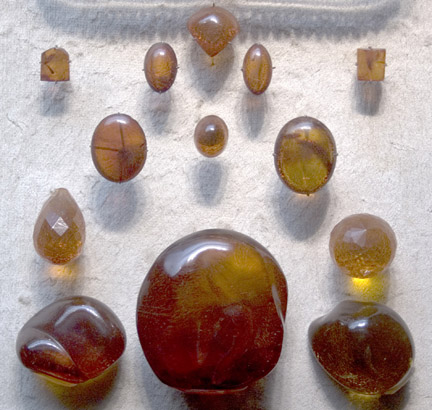
Amber can be carved and takes a good polish. It is used in beads and other jewelry and is carved into utilitarian objects such a pipe stems. Amber is very light and large pieces can be used in pendants. In fact amber is so light that it floats in a solution of saltwater; some Baltic amber is collected off of beaches after storms wash the light weight amber ashore.
The movie Jurassic Park featured amber which contained insects. The insects had bitten dinosaurs and taken blood that contained their DNA. The dinosaur DNA was extracted and used to resurrected dinosaurs. Though this method of getting dinosaur DNA will most likely never by successful, the insects and other material stored in amber is of great scientific interest in such field as the study of insect evolution and related biological studies.
Amber is simulated using several types of resin such a natural copal (this becomes sticky on the surface when polished) and synthetic resins such as plastics made of bakelite, casein, epoxy. The synthetic resins have an unpleasant odor when melted or burned. They also tend to peel rather than chip when cut with a sharp knife.
Shell Material
Seashells have a beauty of their own. The shape of a shell has a natural/organic appearance that is pleasurable to observe. But shells have inner beauty as well. For instance, shell material can be carved into cameos that take advantage of different coloration on the shell, or if the shell has superior mother-of-pearl, it can be dazzling to see the shell's interior. Mother-of-pearl was an important industry, particularly in the of making buttons, but has largely been replaced by plastics. Shell materials' many colors and textures are and have been a source of inspiration to artists.
Though the cost of mother-of-pearl is only moderate, but it can make attractive costume jewelry.
Ammolite
Below are fragments of the fossilized shells of extinct animals from the class of mollusks known as cephalopods and a picture showing a reproduction of how these animals appeared in life. These creatures were related to octopuses and squids and have tentacles and larges eyes but had a protective shell. The shells of these creatures are calcium carbonate and the interior of these creatures was coated with mother-of -pearl The shell pieces retain their mother-of-pearl-like coating even though they are tens of millions to perhaps a hundred million years old!
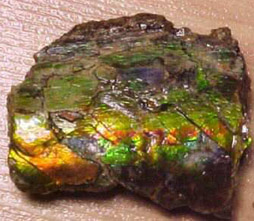
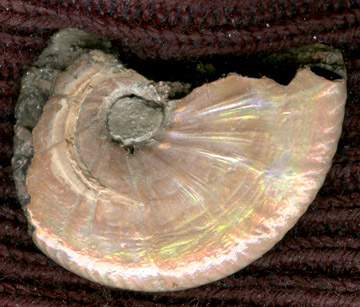
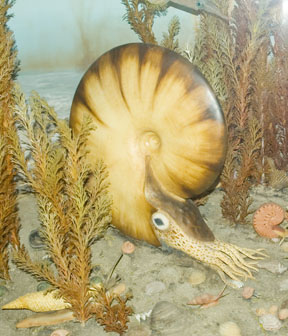
Ammolite is the commercial name given to this fossilizedl shell material that retains its nacreous appearence and is used in jewelry. This material is mostly derived from the shells of fossilized ammonites (a type of cephalopod mollusk). The material is used in much the same way as mother-of-pearl. One difference is that the colors seen in ammolite tend to be darker with more red, orange, and green than seen in most modern mother-of-pearl.
Tortoise Shell
The shell of turtles has been employed to make utilitarian articles
such as combs and hair clips. However, sea turtles, the source of
this material, are so endangered that all use of this material should be
abandoned. Colored plastics do a very adequate job of replacing tortoise
shell. Seeing a living sea turtle is much more of a thrill
than having an ornament made of its shell.
American Museum of Natural History website on amber